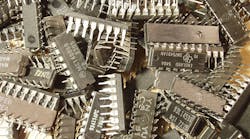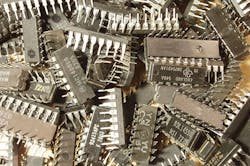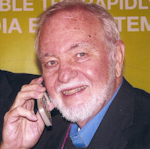I’m in the process of updating my basic electronics book Electronics Explained (Newnes/Elsevier, 2010) for a second edition. I’m adding some hands-on experiments and projects that have the reader build some interesting demo circuits on breadboarding sockets. I usually order the parts I need from online supplier Jameco and occasionally from All Electronics and Mouser.
Looking through the catalog, it dawned on me that the company still stocks lots of the older ICs and transistors, some introduced way back in the 1970s. In fact, I see dozens of them. I discovered that distributors like these still sell millions of these throwback parts each year. Why?
Defying Obsolescence
Remember the 555 timer and the 741 op amp? These parts were first introduced in the 1970s. If you’re an engineer from that era, you may have used them in a design. I did. Even if you’re a recent grad, you may have come across them as parts used in a college lab experiment. And if you’re a hobbyist or experimenter, you surely know about these oldie-but-goodie parts.
Some other popular parts still hanging around are the LM317 and 7805 regulators. You can also order the LM301 op amp, LM311 comparator, and the LM386 audio amp. Other memorable parts include the MC1458 dual op amp, the NE565 PLL, and the CA3080 transconductance amp—remember that? Also still in the mix are the MC1496 balanced modulator, NE602 mixer, and the XR2206 function generator.
As for digital ICs, the old 7400 series continues to dominate in all its variations. The 74LS low-power TTL versions remain popular, and the 74HC CMOS equivalents are widely used. Also still available are the 4000 series CMOS parts. Maybe you recall the popular CD4017 decade counter or the CD4046 PLL.
It’s still possible to acquire old micros such as the 6502, 6800, 8080, 8031, and Z80. Like me, many of you learned micros on one of these chips. All are packaged in a 40-pin DIP, something you don’t see today.
Your favorite tried-and-true transistors can be had, too, like the 2N2222, 2N2907, 2N3904, 2N4401, MPF102, and 2N3055. Old but still good MOSFETs are the IRF510 and the 2N7000. And let’s not forget the 1N4001 and 1N4148 diodes.
What’s So Good About Retro?
The main question is, why are these so-called dated parts still around? Here’s what I think.
First, these parts work just fine as is, and they’re still “good enough” for many designs. They’re proven, reliable, and forgiving. Second, lots of references use these parts. Thousands of articles, books, app notes, datasheets, and online sources let you come up with a design fast and easy. Third, these parts are cheap. Most can be bought for less than a dollar with a few exceptions. And since these parts can be found at multiple sources, acquisition is fast and easy.
Finally, the ICs are large by today’s standards and use the dual-inline package (DIP). They’re easy to work with and readily plug into the widely used breadboarding sockets. On the other hand, modern surface-mount parts can be tough to work with. They’re small and require special tools, manual dexterity, and great eyesight.
Thousands of hobbyists and experimenters buy DIP parts simply because building with them is an easier process. Just look at the projects in popular hobbyist magazines like Nuts & Volts, Circuit Cellar, Elektor, and Make. Most use the older DIP chips.
What I really wonder is, does anyone really design new products with these chips? Probably not. Today almost everything is micro-based and SMT. If you need a multivibrator oscillator, you no longer go for the 555 timer IC. Instead, you program a cheap 8-bit PIC processor to do the same thing. And it makes sense to use a single, embedded controller chip instead of multiple TTL or CMOS chips for most digital applications. But it’s more difficult to do something equivalent with linear circuits. That’s why so many old op amps and other linears are still around.
I just breadboarded a demo circuit that shows binary counting. It uses a 74HC161 4-bit binary counter driven by a 555 timer clock. The flip-flop outputs have enough current to directly drive the four blue LEDs. It’s one of the new projects in my updated book, and it only took me a few minutes to build. The circuit should be a cheap and easy build for a newcomer to electronics. SMT is too off-putting.
Do you still design with retro parts? What are they and how are they used?



